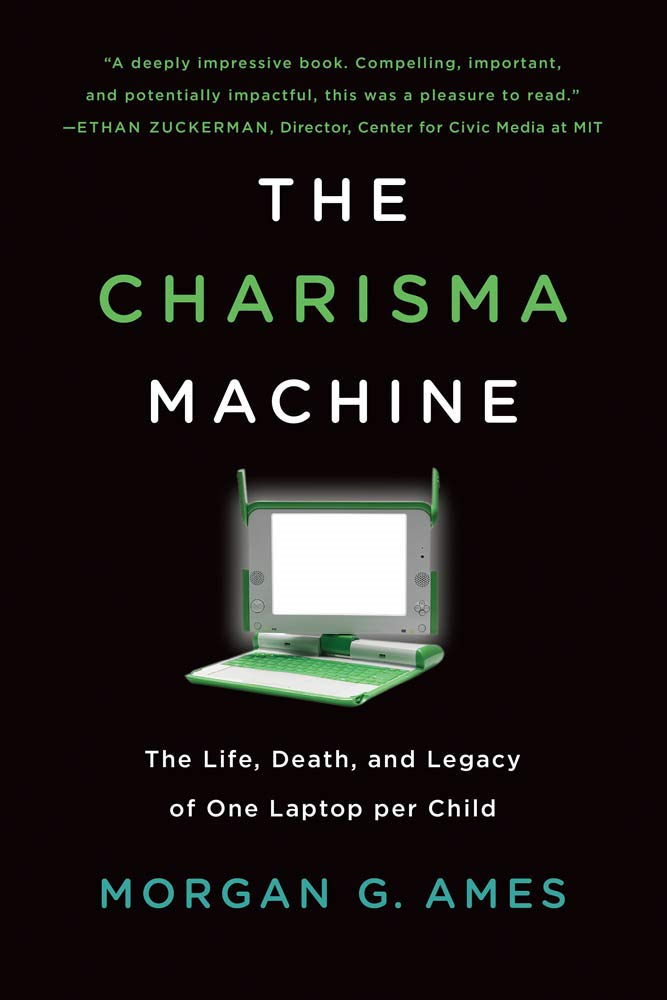
Morgan Ames’ book The Charisma Machine has influenced my thinking more than any other book I’ve read in the last couple years. She writes the story of the XO Laptop from the One Laptop Per Child (OLPC) project. Her summary of the book appears on her website:
The Charisma Machine chronicles the life and legacy of the One Laptop per Child project and explains why—despite its failures—the same utopian visions that inspired OLPC still motivate other projects trying to use technology to “disrupt” education and development.
Announced in 2005 by MIT Media Lab cofounder Nicholas Negroponte, One Laptop per Child promised to transform the lives of children across the Global South with a small, sturdy, and cheap laptop computer, powered by a hand crank. In reality, the project fell short in many ways, starting with the hand crank, which never materialized. Yet the project remained charismatic to many who were enchanted by its claims of access to educational opportunities previously out of reach. Behind its promises, OLPC, like many technology projects that make similarly grand claims, had a fundamentally flawed vision of who the computer was made for and what role technology should play in learning.
The quickest possible summary of the book might be that Negroponte convinced a bunch of people to buy into his vision for the XO laptop, and he turned out to be wrong. The point of the book isn’t the punchline, but is Morgan’s storytelling and empathy that she has for all the participants in the narrative. She understands the big and important vision that Negroponte was promoting and why he was promoting it. She develops the construct of “charisma” to explain why people bought in to this vision. Most of all, she has empathy for the teachers and children who tried to use the XO laptop — mostly unsuccessfully.
She talks specifics about what worked and what didn’t, based in part on her fieldwork in Paraguay. She found that most children who owned XO laptops didn’t use them, either because the laptops broke or because the students found them boring. While XO laptops were famously rugged while closed, they were often damaged while open. Features like the mesh network worked so badly that they were quickly turned off. Teachers struggled to incorporate the laptop into their lessons because of a lack of infrastructure (classes where Morgan visited had only a single power plug), broken or failing XO laptops (battery life was much shorter than expected), or deleted software. The OLPC project insisted that the computers belong to the children, not the school, so children would simply delete programs to make room for videos and games.
I didn’t understand all of her story. She talks about the XO as being developed by and for “technically precocious boys.” I don’t see how gender played a role here. Using “boys” diminishes the roles of Cynthia Solomon (co-developer of Logo with Seymour Papert, Wally Feurzeig, and Danny Bobrow), Paula Bontá (co-developer of Turtle Art, one of the more popular applications on the XO), and Mary Lou Jepsen who served as the chief technology officer for the project.
There are several important themes developed in the book. The one that most resonated for me was the lack of a human-centered development process. Negroponte famously dismissed the idea of a pilot study.
“The days of pilot projects are over. When people say, ‘Well, we’d like to do three or four thousand in our country to see how it works.’ Screw you. Go to the back of the line and someone else will do it, and then when you figure out that this works, you can join as well.”
It’s not clear that there was a feedback loop from the users back to the designers. Unused or unusable features might have been removed earlier if there was. Negroponte had enormous faith in his team’s ability to design software, without ever meeting any user, that would change the user’s life. In the software engineering world, this might be called an example of the “waterfall method” of development — literally, build the technology and throw it over the proverbial wall:
“We’ll take tablets and drop them out of helicopters into villages that have no electricity and school, then go back a year later and see if the kids can read.”
It takes humility to design software that humans will use successfully. The human-computer interaction (HCI) community has developed a rich set of methods for figuring out what users need and might use, and for evaluating the potential of a new interface. To use these methods requires us to recognize our limitations — that we are unlikely to get the design right the first time and that our users know things that we don’t.
Morgan Ames doesn’t use the word hubris in describing the OLPC Project. Rather she uses charisma — “a charismatic technology derives its power experientially and symbolically through the possibility or promise of action: what is important is not what the object is but how it invokes the imagination through what it promises to do.” Everyone wanted the XO laptop to succeed, for the technology to have a powerful effect on children’s lives in the Global South. In hindsight, the challenges of the Global South are probably not solvable with laptop technology. But our imagination is still captured by the possibility. She doesn’t use the word “humility” in describing the project, but that’s probably the component that was most needed.
Mark Guzdial is professor of electrical engineering and computer science in the College of Engineering, and professor of information in the School of Information, of the University of Michigan.




Join the Discussion (0)
Become a Member or Sign In to Post a Comment